#animal health medicine in india
Text
8 Ways Veterinary Medicine Manufacturers Keep Your Pets Healthy

In the ever-evolving realm of pet care, the role of veterinary medicine providers cannot be overstated. These adept entities serve as the bedrock of your beloved companion's well-being, crafting innovative solutions to keep them in the pink of health. Among the pantheon of such Veterinary Medicine Manufacturers , U K German Pharmaceuticals stand tall, their commitment to excellence resonating across the globe, including in burgeoning hubs like India. Let's delve into the remarkable strategies these companies employ to ensure your pets lead flourishing lives.
Pioneering Research and Development: At the heart of every breakthrough lies robust research and development. Manufacturers of veterinary medicine devote considerable resources to pioneering studies, and exploring novel treatments and preventative measures. Through tireless experimentation and analysis, they unearth solutions that address the diverse health needs of pets, from common ailments to rare conditions.
Stringent Quality Assurance Protocols: Upholding unwavering standards, Manufacturers of veterinary medicine implement stringent quality assurance protocols at every stage of production. From sourcing premium ingredients to meticulous manufacturing processes, every facet is scrutinized to deliver products of impeccable quality. Such dedication ensures that your furry companions receive nothing but the finest formulations.
Collaboration with Veterinary Experts: Recognizing the invaluable insights of veterinary professionals, these manufacturers foster collaborative partnerships. By engaging with esteemed veterinarians, they gain invaluable feedback and guidance, refining their products to perfection. This synergy between industry experts ensures that the resulting medications and supplements are tailored to meet the specific needs of pets.
Continuous Innovation in Formulations: Innovation serves as the lifeblood of Veterinary Medicine Companies in India like U K German Pharmaceuticals. Constantly pushing the boundaries of possibility, they evolve their formulations to address emerging health concerns and optimize efficacy. Whether it's enhancing bioavailability or introducing novel delivery mechanisms, each innovation is geared towards enhancing the well-being of your cherished companions.
Embrace of Sustainable Practices: In an era marked by environmental consciousness, Manufacturers of veterinary medicine prioritize sustainability. From eco-friendly packaging to reducing carbon footprints in production, they actively embrace practices that minimize ecological impact. By championing sustainability, they not only safeguard the health of pets but also contribute to the well-being of the planet.
Comprehensive Product Education Initiatives: Education forms the cornerstone of responsible pet care, and Manufacturers of veterinary medicine play a pivotal role in this regard. Through comprehensive product education initiatives, they empower pet owners with knowledge about proper usage, dosage, and potential side effects. Armed with this information, pet parents can make informed decisions to ensure the optimal health of their furry companions.
Adherence to Regulatory Standards: Upholding regulatory standards is non-negotiable for Manufacturers of veterinary medicine. With a steadfast commitment to compliance, they navigate intricate regulatory landscapes with precision and integrity. By adhering to stringent regulations, they instill confidence in their products, assuring pet owners of their safety and efficacy.
Continual Monitoring and Adaptation: The landscape of pet health is dynamic, demanding continual monitoring and adaptation. Manufacturers of veterinary medicine remain vigilant, closely tracking evolving trends and scientific advancements. This proactive approach enables them to swiftly adapt their strategies and formulations, ensuring that pets receive the best possible care in an ever-changing world.
In conclusion,
Veterinary Medicine Manufacturers in India like U K German Pharmaceuticals stand as paragons of excellence in safeguarding the health and well-being of pets. Through a potent blend of innovation, collaboration, and unwavering dedication, they elevate pet care to unprecedented heights. As guardians of our beloved companions, their tireless efforts resonate not only in India but across the globe, enriching the lives of countless furry friends.
#veterinary medicine Companies in India#veterinary medicine manufacturers#animal health medicine in india
0 notes
Text
#Top Veterinary Products Company in India#Top Animal Health Companies in India#List of Top Veterinary Medicine Companies in India#List of Top 10 Veterinary Companies In India
0 notes
Text
The Best News of Last Week - April 3, 2023
Kentucky Legalizes Medical Marijuana in Bipartisan Vote After Decade of Failed Attempts

The state of Kentucky has legalized the use of medical marijuana. The bill received final passage on Thursday. Democratic Gov. Andy Beshear signed it into law Friday morning after a decade of failed attempts in the state legislature.
The news makes Kentucky at least the 38th state in the U.S. to legalize medical marijuana.
Now Indiana is surrounded by weed states. The encirclement is complete 😂
2. The Maryland House of Delegates voted Saturday to approve the Trans Health Equity Act

The Maryland House of Delegates voted Saturday to approve the Trans Health Equity Act — a bill that just a year ago disappeared from the chamber’s agenda ahead of a floor vote.
The bill would require Maryland Medicaid, beginning on Jan. 1, 2024, to provide coverage for additional gender-affirming treatments, which are currently disallowed in the state’s plan but commonly covered by private insurance. The expanded treatments include hormone therapy, hair alteration, voice therapy, physical alterations to the body, and fertility preservation.
3. FDA approves over-the-counter Narcan. Here's what it means

The approved nasal spray is the best-known form of naloxone. It can reverse overdoses of opioids, including street drugs such as heroin and fentanyl and prescription versions including oxycodone.
Making naloxone available more widely is seen as a key strategy to control the nationwide overdose crisis. Effects begin within two minutes when given intravenously, and within five minutes when injected into a muscle. The medicine can also be administered by spraying it into a person's nose.
4. Boston expands tuition-free community college program to all residents

Boston has expanded its tuition-free community college program to include all city residents regardless of age, income or immigration status.
Starting this fall, any city resident will be eligible to pursue an associate’s degree or certificate at one of six partnering local institutions without paying to attend. The program also includes a $250 stipend for incidental expenses each semester for up to three years, and up to $2,500 of debt relief for students whose account balances are keeping them from re-enrolling.
5. First cheetah cubs born in India since extinction 70 years ago

India has welcomed the birth of four cheetah cubs - more than 70 years after the animals were declared officially extinct there.India's environment minister announced the good news, calling it a "momentous event".
The country has been trying to reintroduce the big cats for decades, and last year brought eight cheetahs over from Namibia as part of the plan. Another 12 cheetahs were brought to India from South Africa last month.
6. BBC education show in Afghanistan helps children banned from school
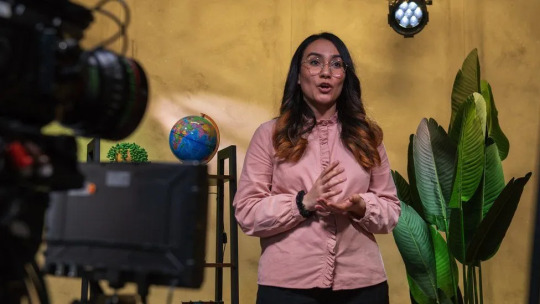
The BBC has launched a new education programme for children in Afghanistan who are banned from school.It is aimed at children aged 11 to 16, including girls whose secondary education has been stopped by the ruling Taliban.
The weekly programme is called Dars, which means lesson in Dari and Pashto, Afghanistan's official languages. It is hosted by BBC Afghan female journalists who were evacuated from Kabul during the 2021 Taliban takeover.
Each new weekly half-hour episode of Dars will air four times a day, Saturday to Friday, on the newly launched BBC News Afghanistan channel.
7. A Trans Creator Has Raised Over 1.5 Million for Trans Healthcare on TikTok Live

Transgender TikTokers are celebrating Trans Day of Visibility by raising over $1.5 million for gender-affirming care around the world.
Mercury Stardust — a DIY TikToker and trans advocate who calls herself the “Trans Handy Ma’am” — raised $120,000 last year in a livestream for the mutual aid nonprofit Point of Pride, which maintains funds for surgeries, hormone therapy, and free binders and gaffs. This year, Stardust and cohost Jory, a.k.a. AlluringSkull, set themselves a goal of raising $1 million in a planned 30-hour live stream…and then smashed that milestone less than six hours after starting the stream Thursday evening.
----
I have started a Youtube channel with wholesome videos I can find on the internet. Check it out :)
That's it for this week :)
This newsletter will always be free. If you liked this post you can support me with a small kofi donation:
Buy me a coffee ❤️
Also don’t forget to reblog
436 notes
·
View notes
Note
hi! SUPER interesting excerpt on ants and empire; adding it to my reading list. have you ever read "mosquito empires," by john mcneill?
Yea, I've read it. (Mosquito Empires: Ecology and War in the Greater Caribbean, 1620-1914, basically about influence of environment and specifically insect-borne disease on colonial/imperial projects. Kinda brings to mind Centering Animals in Latin American History [Few and Tortorici, 2013] and the exploration of the centrality of ecology/plants to colonialism in Plants and Empire: Colonial Bioprospecting in the Atlantic World [Schiebinger, 2007].)
If you're interested: So, in the article we're discussing, Rohan Deb Roy shows how Victorian/Edwardian British scientists, naturalists, academics, administrators, etc., used language/rhetoric to reinforce colonialism while characterizing insects, especially termites in India and elsewhere in the tropics, as "Goths"; "arch scourge of humanity"; "blight of learning"; "destroying hordes"; and "the foe of civilization". [Rohan Deb Roy. “White ants, empire, and entomo-politics in South Asia.” The Historical Journal. October 2019.] He explores how academic and pop-sci literature in the US and Britain participated in racist dehumanization of non-European people by characterizing them as "uncivilized", as insects/animals. (This sort of stuff is summarized by Neel Ahuja, describing interplay of race, gender, class, imperialism, disease/health, anthropomorphism. See Ahuja's “Postcolonial Critique in a Multispecies World.”)
In a different 2018 article on "decolonizing science," Deb Roy also moves closer to the issue of mosquitoes, disease, hygiene, etc. explored in Mosquito Empires. Deb Roy writes: 'Sir Ronald Ross had just returned from an expedition to Sierra Leone. The British doctor had been leading efforts to tackle the malaria that so often killed English colonists in the country, and in December 1899 he gave a lecture to the Liverpool Chamber of Commerce [...]. [H]e argued that "in the coming century, the success of imperialism will depend largely upon success with the microscope."''
Deb Roy also writes elsewhere about "nonhuman empire" and how Empire/colonialism brutalizes, conscripts, employs, narrates other-than-human creatures. See his book Malarial Subjects: Empire, Medicine and Nonhumans in British India, 1820-1909 (published 2017).
---
Like Rohan Deb Roy, Jonathan Saha is another scholar with a similar focus (relationship of other-than-human creatures with British Empire's projects in Asia). Among his articles: "Accumulations and Cascades: Burmese Elephants and the Ecological Impact of British Imperialism." Transactions of the Royal Historical Society. 2022. /// “Colonizing elephants: animal agency, undead capital and imperial science in British Burma.” BJHS Themes. British Society for the History of Science. 2017. /// "Among the Beasts of Burma: Animals and the Politics of Colonial Sensibilities, c. 1840-1940." Journal of Social History. 2015. /// And his book Colonizing Animals: Interspecies Empire in Myanmar (published 2021).
---
Related spirit/focus. If you liked the termite/India excerpt, you might enjoy checking out this similar exploration of political/imperial imagery of bugs a bit later in the twentieth century: Fahim Amir. “Cloudy Swords” e-flux Journal Issue #115. February 2021.
Amir explores not only insect imagery, specifically caricatures of termites in discourse about civilization (like the Deb Roy article about termites in India), but Amir also explores the mosquito/disease aspect invoked by your message (Mosquito Empires) by discussing racially segregated city planning and anti-mosquito architecture in British West Africa and Belgian Congo, as well as anti-mosquito campaigns of fascist Italy and the ascendant US empire. German cities began experiencing a non-native termite infestation problem shortly after German forces participated in violent suppression of resistance in colonial Africa. Meanwhile, during anti-mosquito campaigns in the Panama Canal zone, US authorities imposed forced medical testing of women suspected of carrying disease. Article features interesting statements like: 'The history of the struggle against the [...] mosquito reads like the history of capitalism in the twentieth century: after imperial, colonial, and nationalistic periods of combatting mosquitoes, we are now in the NGO phase, characterized by shrinking [...] health care budgets, privatization [...].' I've shared/posted excerpts before, which I introduce with my added summary of some of the insect-related imagery: “Thousands of tiny Bakunins”. Insects "colonize the colonizers". The German Empire fights bugs. Fascist ants, communist termites, and the “collectivism of shit-eating”. Insects speak, scream, and “go on rampage”.
---
In that Deb Roy article, there is a section where we see that some Victorian writers pontificated on how "ants have colonies and they're quite hard workers, just like us!" or "bugs have their own imperium/domain, like us!" So that bugs can be both reviled and also admired. On a similar note, in the popular imagination, about anthropomorphism of Victorian bugs, and the "celebrated" "industriousness" and "cleverness" of spiders, there is: Claire Charlotte McKechnie. “Spiders, Horror, and Animal Others in Late Victorian Empire Fiction.” Journal of Victorian Culture. December 2012. She also addresses how Victorian literature uses natural science and science fiction to process anxiety about imperialism. This British/Victorian excitement at encountering "exotic" creatures of Empire, and popular discourse which engaged in anthropormorphism, is explored by Eileen Crist's Images of Animals: Anthropomorphism and Animal Mind and O'Connor's The Earth on Show: Fossils and the Poetics of Popular Science, 1802-1856.
Related anthologies include a look at other-than-humans in literature and popular discourse: Gothic Animals: Uncanny Otherness and the Animal With-Out (Heholt and Edmunson, 2020). There are a few studies/scholars which look specifically at "monstrous plants" in the Victorian imagination. Anxiety about gender and imperialism produced caricatures of woman as exotic anthropomorphic plants, as in: “Murderous plants: Victorian Gothic, Darwin and modern insights into vegetable carnivory" (Chase et al., Botanical Journal of the Linnean Society, 2009). Special mention for the work of Anna Boswell, which explores the British anxiety about imperialism reflected in their relationships with and perceptions of "strange" creatures and "alien" ecosystems, especially in Aotearoa. (Check out her “Anamorphic Ecology, or the Return of the Possum.” Transformations. 2018.)
And then bridging the Victorian anthropomorphism of bugs with twentieth-century hygiene campaigns, exploring "domestic sanitation" there is: David Hollingshead. “Women, insects, modernity: American domestic ecologies in the late nineteenth century.” Feminist Modernist Studies. August 2020. (About the cultural/social pressure to protect "the home" from bugs, disease, and "invasion".)
---
In fields like geography, history of science, etc., much has been said/written about how botany was the key imperial science/field, and there is the classic quintessential tale of the British pursuit of cinchona from Latin America, to treat mosquito-borne disease among its colonial administrators in Africa, India, and Southeast Asia. In other words: Colonialism, insects, plants in the West Indies shaped and influenced Empire and ecosystems in the East Indies, and vice versa. One overview of this issue from Early Modern era through the Edwardian era, focused on Britain and cinchona: Zaheer Baber. "The Plants of Empire: Botanic Gardens, Colonial Power and Botanical Knowledge." May 2016. Elizabeth DeLoughrey and other scholars of the Caribbean, "the postcolonial," revolutionary Black Atlantic, etc. have written about how plantation slavery in the Caribbean provided a sort of bounded laboratory space. (See Britt Rusert's "Plantation Ecologies: The Experiential Plantation [...].") The argument is that plantations were already of course a sort of botanical laboratory for naturalizing and cultivating valuable commodity plants, but they were also laboratories to observe disease spread and to practice containment/surveillance of slaves and laborers. See also Chakrabarti's Bacteriology in British India: laboratory medicine and the tropics (2012). Sharae Deckard looks at natural history in imperial/colonial imagination and discourse (especially involving the Caribbean, plantations, the sea, and the tropics) looking at "the ecogothic/eco-Gothic", Edenic "nature", monstrous creatures, exoticism, etc. Kinda like Grove's discussion of "tropical Edens" in the colonial imagination of Green Imperialism.
Dante Furioso's article "Sanitary Imperialism" (from e-flux's Sick Architecture series) provides a summary of US entomology and anti-mosquito campaigns in the Caribbean, and how "US imperial concepts about the tropics" and racist pathologization helped influence anti-mosquito campaigns that imposed racial segregation in the midst of hard labor, gendered violence, and surveillance in the Panama Canal zone. A similar look at manipulation of mosquito-borne disease in building empire: Gregg Mitman. “Forgotten Paths of Empire: Ecology, Disease, and Commerce in the Making of Liberia’s Plantation Economy.” Environmental History. 2017. (Basically, some prominent medical schools/departments evolved directly out of US military occupation and industrial plantations of fruit/rubber/sugar corporations; faculty were employed sometimes simultaneously by fruit companies, the military, and academic institutions.) This issue is also addressed by Pratik Chakrabarti in Medicine and Empire, 1600-1960 (2014).
---
Meanwhile, there are some other studies that use non-human creatures (like a mosquito) to frame imperialism. Some other stuff that comes to mind about multispecies relationships to empire:
Lawrence H. Kessler. “Entomology and Empire: Settler Colonial Science and the Campaign for Hawaiian Annexation.” Arcadia (Spring 2017)
No Wood, No Kingdom: Political Ecology in the English Atlantic (Keith Pluymers)
Archie Davies. "The racial division of nature: Making land in Recife". Transactions of the Institute of British Geographers Volume 46, Issue 2, pp. 270-283. November 2020.
Yellow Fever, Race, and Ecology in Nineteenth-Century New Orleans (Urmi Engineer Willoughby, 2017)
Pasteur’s Empire: Bacteriology and Politics in France, Its Colonies, and the World (Aro Velmet, 2022)
Tom Brooking and Eric Pawson. “Silences of Grass: Retrieving the Role of Pasture Plants in the Development of New Zealand and the British Empire.” The Journal of Imperial and Commonwealth History. August 2007.
Under Osman's Tree: The Ottoman Empire, Egypt, and Environmental History (Alan Mikhail)
The Herds Shot Round the World: Native Breeds and the British Empire, 1800-1900 (Rebecca J.H. Woods, 2017)
Imperial Bodies in London: Empire, Mobility, and the Making of British Medicine, 1880-1914 (Kristen Hussey, 2021)
Red Coats and Wild Birds: How Military Ornithologists and Migrant Birds Shaped Empire (Kirsten Greer, 2020)
Animality and Colonial Subjecthood in Africa: The Human and Nonhuman Creatures of Nigeria (Saheed Aderinto, 2022)
Imperial Creatures: Humans and Other Animals in Colonial Singapore, 1819-1942 (Timothy P. Barnard, 2019)
Biotic Borders: Transpacific Plant and Insect Migration and the Rise of Anti-Asian Racism in America, 1890-1950 (Jeannie N. Shinozuka)
#ecology#bugs#multispecies#landscape#indigenous#haunted#temporal#colonial#imperial#british entomology in india#mosquitoes#carceral#tidalectics#intimacies of four continents#carceral geography#pathologization
86 notes
·
View notes
Text
When I used to watch the early seasons of the FT anime , something about Jellal always struck me as distinct about his features. His eyes always looked more prominent than the rest of the guys and I have cracked why.
My guy is wearing Kohl/Surma/Kajal.

Like LOOK at how defined his eyes are compared to another character , you can’t tell me the guy isn’t putting something on. Especially when no other guy or girl character has such defined eye looks (other than Macbeth but it’s obvious he’s wearing eyeliner)
Yes people might say art style for the first season I can agree but look at the characters and then Jellal and tell me if there isn’t something more there.





Look at the guys here , they have dark lashlines but nowhere NEAR as dark and prominent as Jellal.


Even compared to girls from the first season Jellal has a darker and more thicker lash line compared to them.

Look at the difference between him and Erza side by side! He definitely has a more defined lash line!
And look compared to FT girls eyes, when it is the convention of girls usually having the darker lashline in anime.




And then Jellal


There's a clear distinction! His is not just more defined and connected compared to men in FT but also females too!
The reason I have come to the conclusion of Kohl/Kajal/Surma is because I HC Jellal with Arab heritage (or whatever would be the equivalent in earthland-) due to his name Jellal (which is basically another spelling of Jalal) and Kohl is known to be used by the men in the Arab culture to beautify them. And also Kohl is used by people in Arabia/India/Egypt due to its medicinal properties for retaining eye health and improving vision!
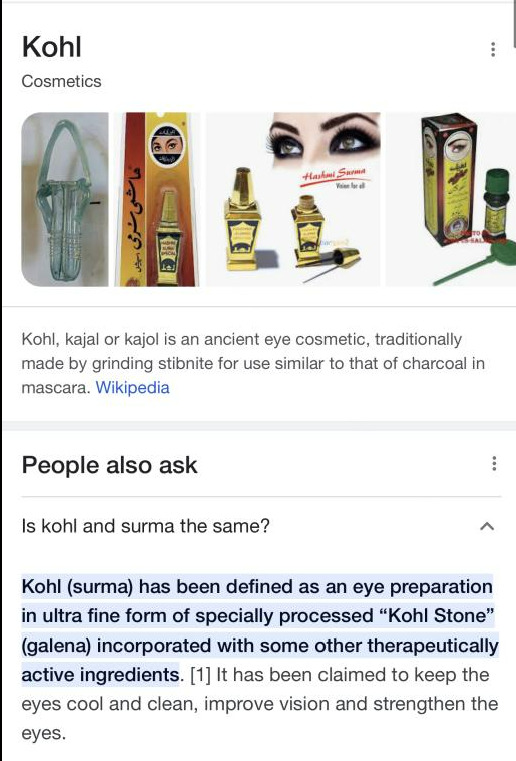
Also what differentiates for my thinking that Jellal is not using normal eyeliner but Kohl/Surma/Kajal is because of the way it is applied. Other eyeliners can go on the outer eye but Kohl/Surma is traditionally applied always in the inner corners of the eyes, just like Jellal has (in season 1)



(As you can see the girl in the photo above has her eyes lined like Jellal using Kohl/Surma/Kajal)

Considering Jellal’s magic , I can imagine there is a huge priority on his vision due to the speeds he travels at when casting, so it makes sense for him to use such a thing to help him in battle or aid in beating the consequences of using his magic so his sight isn’t compromised and remains strong!
Also because Jellal's magic revolves around using stars/light , this medicinal cosmetic has also been used to protect against the glare of light which would also come to help for Jellal in battle!

So what is the take away from this post? I put way too much thought trying to prove a HC I have had from young but found out it actually adds up now looking at the facts. You guys can tell me if i'm reaching or not with this after seeing the evidence and argument presented.

Also season 1 Jellal Fernandes is an ethnic king and we stan he never forgot his roots. <3

#jellal fernandes#jellal fernandez#ft jellal#Jellal#fairy tail jellal#fairy tail#hc#fairy tail headcanons#heritage hc#ethnicity hc#arabian jellal#egyptian jellal#indian jellal#south asian Jellal#north african Jellal#Jellal has to have ONE of these heritages named above (or maybe mutiple idk??)#ethnic jellal#POC Jellal#kohl#surma#eye kajal#kohl/kajal/surma on anime characters#I put way too much thought into this but it adds up#my first hc post lol#yamishika's hcs
78 notes
·
View notes
Text
The Ig Nobel Prize, for scientific research that makes people laugh and then makes them think. This year's winners!
CHEMISTRY and GEOLOGY PRIZE [POLAND, UK]
Jan Zalasiewicz, for explaining why many scientists like to lick rocks.
REFERENCE: “Eating Fossils,” Jan Zalasiewicz, The Paleontological Association Newsletter, no. 96, November 2017. Eating fossils | The Palaeontological Association (palass.org)
WHO TOOK PART IN THE CEREMONY: Jan Zalasiewicz
LITERATURE PRIZE [FRANCE, UK, MALAYSIA, FINLAND]
Chris Moulin, Nicole Bell, Merita Turunen, Arina Baharin, and Akira O’Connor for studying the sensations people feel when they repeat a single word many, many, many, many, many, many, many times.
REFERENCE: “The The The The Induction of Jamais Vu in the Laboratory: Word Alienation and Semantic Satiation,” Chris J. A. Moulin, Nicole Bell, Merita Turunen, Arina Baharin, and Akira R. O’Connor, Memory, vol. 29, no. 7, 2021, pp. 933-942. doi.org/10.1080/09658211.2020.1727519
WHO TOOK PART IN THE CEREMONY: Chris Moulin, Akira O’Connor
MECHANICAL ENGINEERING PRIZE [INDIA, CHINA, MALAYSIA, USA]
Te Faye Yap, Zhen Liu, Anoop Rajappan, Trevor Shimokusu, and Daniel Preston, for re-animating dead spiders to use as mechanical gripping tools.
REFERENCE: “Necrobotics: Biotic Materials as Ready-to-Use Actuators,” Te Faye Yap, Zhen Liu, Anoop Rajappan, Trevor J. Shimokusu, and Daniel J. Preston, Advanced Science, vol. 9, no. 29, 2022, article 2201174. doi.org/10.1002/advs.202201174
WHO TOOK PART IN THE CEREMONY: Te Faye Yap and Daniel Preston
PUBLIC HEALTH PRIZE [SOUTH KOREA, USA] Seung-min Park, for inventing the Stanford Toilet, a device that uses a variety of technologies — including a urinalysis dipstick test strip, a computer vision system for defecation analysis, an anal-print sensor paired with an identification camera, and a telecommunications link — to monitor and quickly analyze the substances that humans excrete.
REFERENCE: “A Mountable Toilet System for Personalized Health Monitoring via the Analysis of Excreta,” Seung-min Park, Daeyoun D. Won, Brian J. Lee, Diego Escobedo, Andre Esteva, Amin Aalipour, T. Jessie Ge, et al., Nature Biomedical Engineering, vol. 4, no. 6, 2020, pp. 624-635. doi.org/10.1038/s41551-020-0534-9
REFERENCE: “Digital Biomarkers in Human Excreta,” Seung-min Park, T. Jessie Ge, Daeyoun D. Won, Jong Kyun Lee, and Joseph C. Liao, Nature Reviews Gastroenterology and Hepatology, vol. 18, no. 8, 2021, pp. 521-522. doi.org/10.1038/s41575-021-00462-0
REFERENCE: “Smart Toilets for Monitoring COVID-19 Surges: Passive Diagnostics and Public Health,” T. Jessie Ge, Carmel T. Chan, Brian J. Lee, Joseph C. Liao, and Seung-min Park, NPJ Digital Medicine, vol. 5, no. 1, 2022, article 39. doi.org/10.1038/s41746-022-00582-0
REFERENCE: “Passive Monitoring by Smart Toilets for Precision Health,” T. Jessie Ge, Vasiliki Nataly Rahimzadeh, Kevin Mintz, Walter G. Park, Nicole Martinez-Martin, Joseph C. Liao, and Seung-min Park, Science Translational Medicine, vol. 15, no. 681, 2023, article eabk3489. doi.org/10.1126/scitranslmed.abk3489
WHO TOOK PART IN THE CEREMONY: Seung-min Park
COMMUNICATION PRIZE [ARGENTINA, SPAIN, COLOMBIA, CHILE, CHINA, USA]
María José Torres-Prioris, Diana López-Barroso, Estela Càmara, Sol Fittipaldi, Lucas Sedeño, Agustín Ibáñez, Marcelo Berthier, and Adolfo García, for studying the mental activities of people who are expert at speaking backward.
REFERENCE: “Neurocognitive Signatures of Phonemic Sequencing in Expert Backward Speakers,” María José Torres-Prioris, Diana López-Barroso, Estela Càmara, Sol Fittipaldi, Lucas Sedeño, Agustín Ibáñez, Marcelo L. Berthier, and Adolfo M. García, Scientific Reports, vol. 10, no. 10621, 2020. doi.org/10.1038/s41598-020-67551-z
WHO TOOK PART IN THE CEREMONY: María José Torres-Prioris, Adolfo García
MEDICINE PRIZE [USA, CANADA, MACEDONIA, IRAN, VIETNAM]
Christine Pham, Bobak Hedayati, Kiana Hashemi, Ella Csuka, Tiana Mamaghani, Margit Juhasz, Jamie Wikenheiser, and Natasha Mesinkovska, for using cadavers to explore whether there is an equal number of hairs in each of a person’s two nostrils.
REFERENCE: “The Quantification and Measurement of Nasal Hairs in a Cadaveric Population,” Christine Pham, Bobak Hedayati, Kiana Hashemi, Ella Csuka, Margit Juhasz, and Natasha Atanaskova Mesinkovska, Journal of The American Academy of Dermatology, vol. 83, no. 6, 2020, pp. AB202-AB202. doi.org/10.1016/j.jaad.2020.06.902
WHO TOOK PART IN THE CEREMONY: Christine Pham, Natasha Mesinkovska, Margit Juhasz, Kiana Hashemi, Tiana Mamaghani
NUTRITION PRIZE [JAPAN]
Homei Miyashita and Hiromi Nakamura, for experiments to determine how electrified chopsticks and drinking straws can change the taste of food.
REFERENCE: “Augmented Gustation Using Electricity,” Hiromi Nakamura and Homei Miyashita, Proceedings of the 2nd Augmented Human International Conference, March 2011, article 34. doi.org/10.1145/1959826.1959860
WHO TOOK PART IN THE CEREMONY: Homei Miyashita, Hiromi Nakamura
EDUCATION PRIZE [CHINA, CANADA, UK, THE NETHERLANDS, IRELAND, USA, JAPAN]
Katy Tam, Cyanea Poon, Victoria Hui, Wijnand van Tilburg, Christy Wong, Vivian Kwong, Gigi Yuen, and Christian Chan, for methodically studying the boredom of teachers and students.
REFERENCE: “Boredom Begets Boredom: An Experience Sampling Study on the Impact of Teacher Boredom on Student Boredom and Motivation,” Katy Y.Y. Tam, Cyanea Y. S. Poon, Victoria K.Y. Hui, Christy Y. F. Wong, Vivian W.Y. Kwong, Gigi W.C. Yuen, Christian S. Chan, British Journal of Educational Psychology, vol. 90, no. S1, June 2020, pp. 124-137. doi.org/10.1111/bjep.12549
REFERENCE: “Whatever Will Bore, Will Bore: The Mere Anticipation of Boredom Exacerbates its Occurrence in Lectures,” Katy Y.Y. Tam, Wijnand A.P. Van Tilburg, Christian S. Chan, British Journal of Educational Psychology, epub 2022. doi.org/10.1111/bjep.12549
WHO TOOK PART IN THE CEREMONY: Christian Chan, Katy Y.Y. Tam, Wijnand A.P. Van Tilburg
PSYCHOLOGY PRIZE [USA]
Stanley Milgram, Leonard Bickman, and Lawrence Berkowitz for experiments on a city street to see how many passersby stop to look upward when they see strangers looking upward
REFERENCE: “Note on the Drawing Power of Crowds of Different Size,” Stanley Milgram, Leonard Bickman, and Lawrence Berkowitz, Journal of Personality and Social Psychology, vol. 13, no. 2, 1969, pp. 79-82. psycnet.apa.org/doi/10.1037/h0028070
WHO TOOK PART IN THE CEREMONY: Len Bickman
PHYSICS PRIZE [SPAIN, GALICIA, SWITZERLAND, FRANCE, UK]
Bieito Fernández Castro, Marian Peña, Enrique Nogueira, Miguel Gilcoto, Esperanza Broullón, Antonio Comesaña, Damien Bouffard, Alberto C. Naveira Garabato, and Beatriz Mouriño-Carballido, for measuring the extent to which ocean-water mixing is affected by the sexual activity of anchovies.
REFERENCE: “Intense Upper Ocean Mixing Due to Large Aggregations of Spawning Fish,” Bieito Fernández Castro, Marian Peña, Enrique Nogueira, Miguel Gilcoto, Esperanza Broullón, Antonio Comesaña, Damien Bouffard, Alberto C. Naveira Garabato, and Beatriz Mouriño-Carballido, Nature Geoscience, vol. 15, 2022, pp. 287–292. doi.org/10.1038/s41561-022-00916-3
WHO TOOK PART IN THE CEREMONY: Bieito Fernandez Castro, Beatriz Mouriño-Carballido, Alberto Naveira Garabato, Esperanza Broullon, Miguel Gil Coto
27 notes
·
View notes
Text
Good News From Israel
Israel's Good News Newsletter to 29/1/23
In the 29th Jan 23 edition of Israel’s good news, the highlights include:
Israeli women are the 9th healthiest of 122 countries surveyed.
Israel has good news for IBD sufferers.
Israel added a record value of new medical benefits into its 2023 health basket.
For 60 years a Jerusalem charity has quietly supported the elderly in need.
A new Israeli natural sweetener has 70% less sugar for the same taste.
Israelis enjoy the world's best value Internet service.
A new Israeli factory is to mass-produce flexible solar panels.
An ancient site being excavated in Judea has three Biblical sources.
Read More: Good News From Israel
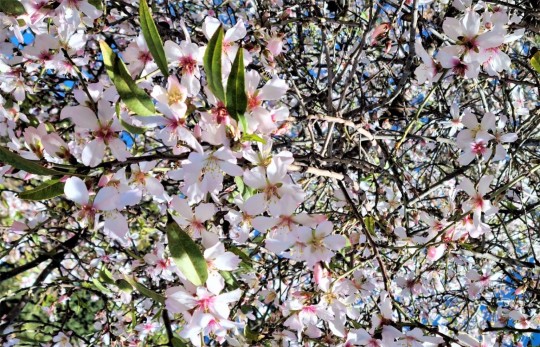
This week's positive Israel newsletter is full of healthy facts and innovations. Israel's subsidized medical treatments have just received a record annual increase of funds. There is news of current and potential treatments for Inflammatory bowel disease, bacterial infections, Parkinson's disease, personalized medicine, and the aging process. No wonder that Israeli women are among the world's healthiest. An Israeli charity looks after the health of the elderly; Sderot's trauma center is a global model of resilience; and the hearing-impaired have a new Israeli app. Meanwhile, Israelis are helping to sustain farmers in India and relieve war-weary civilians in Ukraine.
Israeli startups recently won awards for life-changing inventions. Israeli innovations protect wildlife from oil spills; save the world's coral reefs; convert polluting waste into food and fuel; make packaging that reduces CO2 emissions; create healthier sugar; develop and promote non-animal food alternatives; grow better yielding, sustainable crops and mass-produce flexible solar energy panels.
So come and enjoy our warm winter streets, mind-expanding museums and exhilarating musical events. Or pass on this newsletter to those who are only getting unhealthy messages about the Jewish State.
#aging#antibiotic#Bible#CO2#El Al#good news#health#IBD#India#Israel#Jazz#Jerusalem#Jewish#NATO#Parkinson’s trauma#solar#sugar#UAE#Ukraine#vegan
20 notes
·
View notes
Text
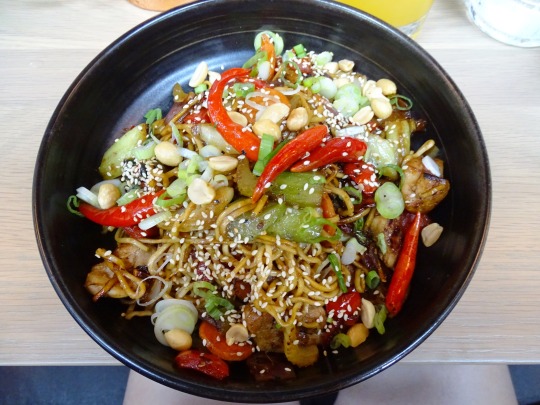
























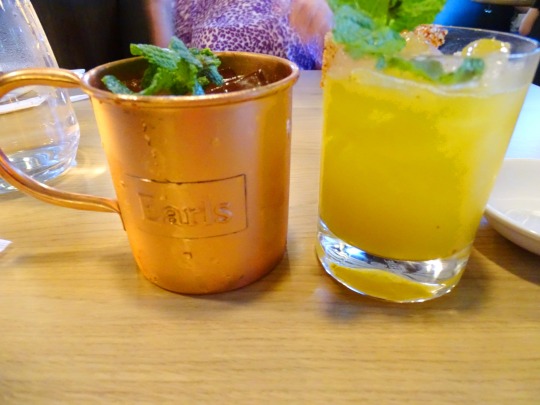

National Hot Heads Chili Day
Chili lovers celebrate National Hot Heads Chili Day on January 17 every year. On this day, chili heads, heat-seekers, and extreme eaters try out the spiciest chilis. National Hot Heads Chili Day is celebrated with habanero-eating challenges, fancy-dress contests, and cook-offs of popular recipes. Chilis are also made to take the official Scoville heat scale. This doesn’t mean that you have to be a daredevil to celebrate the day — anyone who likes their meal a little hot can celebrate the day! Spices and chilis add a distinct flavor to the dish. Thai, Indian, Creole and Caribbean dishes are famous for their heat content and boast of some excellent gastronomic experiences!
History of National Hot Heads Chili Day
We don’t quite know how National Hot Heads Chili Day came to be but it’s safe to say that one fine day all the chili lovers got together and decided to celebrate hot and spicy food. This makes sense given how humans have always had a knack for chilis in their food — the first recipes for spicy foods go back to 6,000 years! This means that humans have been enjoying spicy food for quite some time. While the foods that we enjoy today may have changed and recipes altered, we still love spicy food. Unlike other animals, humans prefer spicy food simply because it tastes so incredible and on a plus side, spices also offer several health benefits.
Spices such as turmeric and cumin that have powerful antimicrobial and antioxidant properties can kill bacteria outright. Studies show that the capsaicin in hot peppers can reduce inflammation and decrease the chances of heart disease. It can also aid in weight loss. In Ayurvedic medicine, the inflammatory properties of chilis have brought relief from many different conditions, such as headaches, autoimmune disorders, and arthritis. Spicy foods can also help fasten your metabolism. Studies also show that certain spices, like pepper chilies, turmeric, cinnamon, and cumin can curb your appetite and improve your metabolic resting rate. Who knew chilis could be so versatile!
National Hot Heads Chili Day timeline
3500 B.C.
Chilis Are Cultivated
Chilis are grown and cultivated for the first time.
1498
Chilis Arrive In India
Vasco-da-Gama reaches Indian shores and introduces India to chilis.
1912
Scoville Organoleptic Test
Wilbur L. Scoville finds a new method to measure the pungency of chilis.
1975
Chili’s
Larry Lavine opens the first Chili's in Dallas.
National Hot Heads Chili Day FAQs
Are chillies native to India?
After the Portuguese arrival in India, chilies were first introduced to Goa, from where they spread to South India. Today, India is the largest producer of red dried chili in the world.
Which chili is the spiciest?
A Guinness Book record holder, Bhut Jolokia is certified as the hottest chili in the world. It is also known as ‘ghost pepper’ and is cultivated in Arunachal Pradesh, Assam, Nagaland, and Manipur.
Which chili is the healthiest?
Green chilies have high water content and zero calories which makes them a healthy choice for those who are trying to shed some pounds.
National Hot Heads Chili Day Activities
Host a dinner party: Chilis are regularly used in Indian, Chinese, and Thai cooking. Host a dinner party and serve these cuisines to friends and family.
Learn about different chilis from around the world: On National Hot Heads Chili Day, learn more about the different chilies that are available around the world. There are so many different types, including Carolina Reapers, Ghost Peppers, Habanero, Red Cayenne Pepper, Serrano, Guajillo, Poblano, Peppadew, and much more.
Organize a cook-off: Invite your friends over and see who can create the best hot and spicy dish. Flavor your dishes with different types of chilis and find out which one is the hottest.
5 Facts About Chilis That Will Blow Your Mind
Chilis can make you happy: They help release feel-good endorphins and dopamine, which results in a sense of euphoria.
The Japanese had an innovative use: Instead of eating them, the Japanese put them in their socks to keep their toes warm.
They are rich in nutrients: They contain large amounts of vitamin C, provitamin A, and beta-carotene.
Only mammals are sensitive to chilis: Capsaicin may burn and irritate the flesh of mammals but birds are completely immune to its effects
They can be used as first aid: Cayenne pepper can help stop bleeding.
Why We Love National Hot Heads Chili Day
A day to enjoy your favorite foods: Most of us love spicy foods but it’s not possible to savor them every day. National Hot Heads Chili Day offers the perfect opportunity to indulge in your favorite spicy food.
Try a new cuisine: If you don't have an adventurous palate, today is the best day to rectify that. Sample spicy foods from India, Thailand, the Philippines, and the Caribbean.
A day to be adventurous: If you are an adventurous foodie, then National Hot Heads Chili Day invites you to taste some of the hottest and steamiest chilies from the world over. Go on a gastronomic adventure today!
Source
#Green Chile Cheeseburger#Chili Cheese Fries#Chili Burger#Green Chili Stew#Chicken Hunan Kung Pao#Eric's Burger#Passionfruit Chili Margarita#National Hot Heads Chili Day#travel#original photography#vacation#USA#Canada#Sweden#restaurant#street food#NationalHotHeadsChiliDay#17 January
3 notes
·
View notes
Text
Holidays 9.30
Holidays
Agricultural Reform Day (Sao Tome and Principe)
Arizona Monsoon Season ends
Army Incompetence Day
Birth of Morelos (Mexico)
Botswana Day (Botswana)
Boy’s Day (Poland)
Chewing Gum Day
Day of Hungarian Folktales (Hungary)
Do Something Wacky With A Grandparent Day
E-mail Debt Forgiveness Day
Frisbee Day
International Blasphemy Rights Day (a.k.a. Blasphemy Day)
International Podcast Day
International Recovery Day
International Thunderbirds Day
International Translation Day (UN)
Jananeta Irawat Birth Day (Manipur, India)
Kokkeisetsu (Japan)
Liberation Day (Abkhazia)
Limb Girdle Muscular Dystrophy Awareness Day
Monkey Bars Day
National Black Funding Day
National Chewing Gum Day
National Day of Remembrance for Indian Boarding Schools
National Kratom Day
National Love People Day
National Microcephaly Awareness Day
National Mud Pack Day
National Nonspeaking / Nonverbal Awareness Day (UK)
National Pet Tricks Day (UK)
National PrepareAthon! Day [also 4.30]
National Puppy Mill Survivor Day
National Sporting Heritage Day (UK)
National Teach Spanish Day
Neonatal Intensive Care Awareness Day
Orange Shirt Day (Canada)
Parsnip Day (French Republic Day)
Peon Day (Warcraft)
Pink Out Day
Rabbit Rabbit Day [Last Day of Every Month]
Recovery Day (Canada)
Rumi Day
Secretary Day (Venezuela)
Thunderbirds Day
Time For Yoga Day
Truth and Reconciliation Day (Canada)
World Pole Dance Day
Food & Drink Celebrations
Austrian Beer Day (Austria)
Extra Virgin Olive Oil Day
Hot Mulled Cider Day
National Hot Mulled Cider Day
National Soufflé Potato Day
World Stroopwafel Day (Netherlands)
5th & Last Saturday in September
Centzon-Totochtin Drunken Rabbit Day [Last Saturday]
Everybody's Day Festival [Last Saturday]
Family Health and Fitness Day USA (Last Saturday]
International Lace Day [Last Saturday]
National Alpaca Farm Days begin [Last Saturday]
National Ghost Hunting Day [Last Saturday]
Nickelodeon’s Worldwide Day of Play [Last Saturday]
Save Your Photos Day [Last Saturday]
World Cyanotype Day [Last Saturday]
World Day of Leukodystrophies [Last Saturday]
Independence Days
Botswana (from UK, 1966)
Republic of Abkhazia (from Georgia, 1983) [unrecognized]
Tinakula (Declared; 2020) [unrecognized]
Feast Days
Aequinoctium Autumnale II (Pagan)
Anthony Green (Artology)
Blue-Feathered Swallowing Swallow (Muppetism)
Feast of Soma (God of Ambrosia & Immortality; India)
Festival of Drunkenness (Ancient Egypt)
Festival of Tereteth (Goddess of the Coconut Toddy; Yap Island, Micronesia)
Gregory the Illuminator (Christian; Saint)
Honorius of Canterbury (Christian; Saint)
Jerome (Christian; Saint)
John Waters Day (Church of the SubGenius; Saint)
Medetrinalia (Fruits Offered to Goddess of Medicine; Ancient Rome)
Molière (Positivist; Saint)
Plan for the 31st if September Day (Pastafarian)
Ridiculous Excuses Day (Pastafarian)
Lucky & Unlucky Days
Taian (大安 Japan) [Lucky all day.]
Uncyclopedia Bad to Be Born Today (because Green Day fans will never leave you alone.)
Premieres
Adjustment Team, by Philip K. Dick (Short Story; 1954)
Alias (TV Series; 2001)
The Ascent Of Rum Doodle, by W.E. Bowman (Novel; 1956)
The Big Chill (Film; 1983)
Bird (Film; 1988)
Blueberries for Sal, by Robert McCloskey (Children’s Book; 1948)
The Boy Friend (Broadway Musical; 1954)
Car Talk (Radio Series; 1977)
Cheers (TV Series; 1982)
The Clock Store (Disney Cartoon; 1931)
Con Man (Web Series; 2015)
Dad, Can I Borrow the Car? (Disney Short Film; 1970)
Death Valley Days (Radio Series; 1930)
Entergalactic (Animated Film; 2022)
The Family of Pascual Duarte, by Camilo José Cela (Novel; 1942)
Fantasy, by Mariah Carey (Song; 1995)
50/50 (Film; 2011)
The Flintstones (Animated TV Series; 1960)
Go Away Stowaway (WB MM Cartoon; 1967)
Grand Ole Opry (TV Series; 1950)
The Graveyard Book, by Neil Gaiman (Novel; 2008)
The Greatest Game Ever Played (Film; 2005)
Into the Blue (Film; 2005)
Little Women (Novel; 1868)
Louis Armstrong Plays King Oliver, recorded by Louis Armstrong (Album; 1957) [1st stereo album]
Love for Sale, by Tony Bennett (Album; 2021)
Luke Cage (TV Series; 2016)
The Magic Flute, by Wolfgang Amadeus Mozart (Opera; 1791)
Marvel Rising: Secret Warriors (Animated Film; 2018)
Methuselah's Children, by Robert A. Heinlein (Novel; 1958)
Miss Peregrine’s Home for Peculiar Children (Film; 2016)
Murder, She Wrote (TV Series; 1984)
Nebraska, by Bruce Springsteen (Album; 1982)
Porgy and Bess, by George Gershwin (Opera; 1935)
The Queen (Film; 2006)
The Rifleman (TV Series; 1958)
The Robe, by Lloyd C. Douglas (Novel; 1942)
The Saint in Europe, by Leslie Charteris (Short Stories 1953) [Saint #30]
Scooby-Doo! And the Monster of Mexico (WB Animated Film; 2003)
A Separate Peace, by John Knowles (Novel; 1959)
Serenity (Film; 2005)
Shine On, by Jet (Album; 2006)
The Steeple-Chase (Disney Cartoon; 1933)
Theme From Shaft, by Isaac Hayes (Song; 1971)
To the Manor Born (UK TV Series; 1979)
You, Me and the Apocalypse (UK TV Series; 2015)
Today’s Name Days
Hieronymus, Urs, Victor (Austria)
Felicija, Grgur, Jerko, Jeronim (Croatia)
Jeroným (Czech Republic)
Hieronymus (Denmark)
Kaur, Kauri, Tauri (Estonia)
Sirja, Siru, Sorja (Finland)
Jérôme (France)
Hieronymus , Urs, Viktor (Germany)
Stratonikos (Greece)
Jeromos (Hungary)
Gerolamo (Italy)
Abgara, Elma, Lamekins (Latvia)
Bytautė, Jeronimas, Sofija, Žymantas (Lithuania)
Hege, Helga, Helge (Norway)
Grzegorz, Hieronim, Honoriusz, Imisław, Leopard, Sofia, Wera, Wiera, Wiktor, Wiktoriusz, Zofia (Poland)
Grigorie (Romania)
Lubov, Nadezhda, Vera (Russia)
Jarolím (Slovakia)
Jerónimo, Sofía, Sonia (Spain)
Helge (Sweden)
Jerome, Jeronima, Gerome, Geromino (USA)
Today is Also…
Day of Year: Day 273 of 2024; 92 days remaining in the year
ISO: Day 6 of week 39 of 2023
Celtic Tree Calendar: Muin (Vine) [Day 26 of 28]
Chinese: Month 8 (Xin-You), Day 16 (Xin-Mao)
Chinese Year of the: Rabbit 4721 (until February 10, 2024)
Hebrew: 15 Tishri 5784
Islamic: 15 Rabi I 1445
J Cal: 3 Shù; Threesday [3 of 30]
Julian: 17 September 2023
Moon: 98%: Waning Gibbous
Positivist: 21 Shakespeare (10th Month) [Molière]
Runic Half Month: Gyfu (Gift) [Day 4 of 15]
Season: Autumn (Day 7 of 89)
Zodiac: Libra (Day 7 of 30)
2 notes
·
View notes
Text
#Top Veterinary Medicine Companies in India#Animal Health Medicine in India#Animal Health Medicine Manufacturers in India#Animal Health Medicine Suppliers in India#veterinary medicine for mastitis treatment#veterinary medicine#animal pharmaceutical companies#veterinary medicine manufacturers#animal pharmaceutical companies in india#animal medicine company in india#veterinary medicine manufacturers in india
0 notes
Text
Sir Patrick Vallance is the UK government’s chief scientific adviser
The relationship between humans and nature is under intense and increasing strain. The report released today by Ipbes, the Intergovernmental Science-Policy Platform on Biodiversity and Ecosystem Services (akin to the IPCC reports on climate change), provides compelling evidence that humans are overexploiting wild species and habitats. Harmful activities, including habitat destruction, poor farming practices and pollution, have altered ecosystems significantly, driving many species past the point of recovery. In Great Britain alone, of the 8,431 species assessed in the 2019 State of Nature report, 1,188 are threatened with extinction. Globally, there are an estimated one million at risk, with biodiversity declining at a faster rate than at any time in human history.
We cannot ignore biodiversity loss. Biodiversity is the variability that exists among all living organisms, between different species, within species including genetic makeup, and in wider ecosystems. Billions of people rely on wild species for food, clean water, energy, income and health and wellbeing. Annually, crops worth up to £480bn are pollinated by a variety of wild animals, and an estimated 4 billion people depend on natural medicines for their healthcare. These vital ecosystem services are fundamentally based on a healthy environment, and this requires biodiversity. Losing biodiversity leaves species and ecosystems less resilient to challenges such as invasive species or pests, meaning there is an increased risk of whole populations being wiped out and destabilising the entire ecological network. Nature is a finite resource, and human self-interest alone should determine that biodiversity must be protected.
Alongside overexploitation, humans are driving biodiversity loss by destroying, polluting and fragmenting habitats across the globe. Many of the UK’s important peatlands, which provide a home for rare species such as the hen harrier, have been drained for agricultural use. The Amazon rainforest is being cleared to such an extent that it may be near a tipping point beyond which it cannot recover.
The climate crisis is exacerbating the issue. Many species simply cannot adapt to the scale and pace of changing temperatures. For example, warming seas and ocean acidification are devastating coral reefs around the world. This year, the Great Barrier Reef suffered its sixth mass bleaching event since 1998 with more than 90% of reefs affected. In many cases, when an ecosystem loses biodiversity, it becomes less able to store carbon, contributing to further climate change. We have a vicious cycle: climate change leads to biodiversity losses, which in turn leads to further climate change. As governments around the world develop plans to reduce carbon emissions and conserve biodiversity, the message isthe message is simple: we must solve both problems together.
What can be done? Just as science has diagnosed the problem, it can provide solutions. Using strong evidence, such as this Ipbes report, governments can develop effective policy. Integrated and collaborative planning can deliver sustainable solutions which address climate change and biodiversity loss simultaneously, protecting and enriching human lives.
In southern India, scientists, Indigenous communities and local government have worked collaboratively to protect and restore mangrove forests. The trees’ interconnecting large-root systems offer protection against rising sea levels, provide habitats for fish and crustaceans, and clean surrounding water. The trees also draw and store carbon from the atmosphere and encourage carbon-rich sediment deposits. The increase in wildlife has benefited small scale fisheries and tourism. Innovative and effective nature-based initiatives such as these could be implemented throughout different landscapes across the planet.
There are also simple day-to-day things we can do to benefit our environment; for instance, reducing food waste. Currently about 30% of all food produced globally goes uneaten, meaning a significant proportion of the resources, and importantly the land used to grow, process, pack and transport it, is wasted and less able to support biodiversity.
Political will and leadership are needed, and the 15th UN Convention on Biological Diversity conference in December, CBD Cop15, provides the next critical opportunity for governments to commit to real ambitious change.
CBD Cop15 could deliver landmark action and be as important for biodiversity as the Paris Agreement is proving for reducing greenhouse gas emissions. It will set the direction for the next decade of international action and beyond. Governments should agree to halt and reverse biodiversity loss by 2030, and develop evidence-based, actionable plans to do so. An important challenge is to define a reliable and simple integrated metric, like carbon emissions have been used for climate goals. At the end of June, negotiators met in Nairobi for their latest attempt to agree the Post-2020 Global Biodiversity Framework, and while progress was made, it did not go far enough.
The last decade’s targets were not met; the next decade’s must be. Credible delivery plans will be required, and we need a robust mechanism for monitoring progress and holding ourselves to account. CBD Cop15 is the time to finalise the framework, and countries must come to the table prepared to make and support ambitious commitments. This is our chance to secure long-lasting agreements to protect our planet.
#biodiversity loss#overexploitation#tipping points#climate change#amazon rainforest#fishing#agriculture#ipbes#great barrier reef
34 notes
·
View notes
Text
Healthy forests, healthy planet, healthy humans.
youtube

Forests are often called the lungs of the planet, because they absorb harmful carbon dioxide and produce life-giving oxygen so it’s no exaggeration to equate healthy forests with healthy people, the theme of this year’s International Day of Forests.
Covering 31 per cent of Earth’s land and providing a home to 80 per cent of all land-based species, forests are crucial to human health and well-being, but their loss across the planet is threatening people everywhere.
Here are five things you need to know about the age-old and ever-growing interlinked relationship between forests and human health.

CityAdapt - Forests are key to building climate resilience.
1. Carbon sinks combat climate change
Forest ecosystems keep the planet healthy by regulating the climate, rainfall patterns, and watersheds and crucially provide the oxygen which is essential to human existence.
Healthy forests help to keep climate change in check by acting as “carbon sinks”, which annually absorb about two billion tonnes of carbon dioxide, the gas which is contributing to climate change and the increase of temperatures globally.
The rapidly changing climate is threatening the very existence of people in many different ways: through death and illness due to extreme weather events, the disruption of food systems, and the increase in diseases. Simply put, without healthy forests, people around the world, especially in the world’s most vulnerable countries, will struggle to lead healthy lives and maybe even to survive.

UN-REDD Forest products are processed into medicine in Viet Nam.
2. Nature’s pharmacies: from masks to medicine cabinets
From masks to medicines, forest products are used around the world every day. As many as 80 per cent of developing nations and one quarter of developed countries depend on plant-based medicinal drugs.
Forests contain about 50,000 plant species used for medicinal purposes by both local communities and multinational pharmaceutical companies. For millennia, forest dwellers have treated a range of ailments using products they have harvested. At the same time, many common pharmaceutical medicines are rooted in forest plants, including cancer-treating drugs from the Madagascar periwinkle and malaria medication, quinine, from cinchona trees.
The One Health approach, launched as part of the UN response to the COVID-19 pandemic, recognizes that the health of humans, animals, plants, and the wider environment, including forests, are closely linked and interdependent.
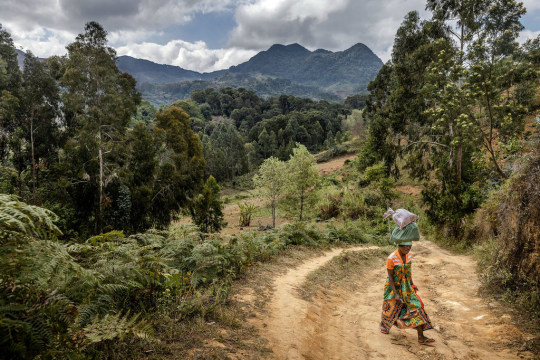
© FAO/ A woman carries goods through Uluguru Nature Forest Reserve in Morogoro, Tanzania.
3. Dinner for 1 billion people
Nearly one billion people globally depend on harvesting wild food such as herbs, fruits, nuts, meat, and insects for nutritious diets. In some remote tropical areas, the consumption of wild animals is estimated to cover between 60 and 80 per cent of daily protein needs.
A study from 43,000 households across 27 countries in Africa found that the dietary diversity of children exposed to forests was at least 25 per cent higher than those who were not.
In 22 countries in Asia and Africa, including both industrialized and developing countries, researchers found that indigenous communities use an average of 120 wild foods per community, and in India, an estimated 50 million households supplement their diets with fruits gathered from wildland forests and surrounding bushland.

UNDP Timor-Leste / Communities in Timor-Leste are helping to restore mangrove forests.
4. Forests are crucial for sustainable development
Forests provide goods and services, employment, and income to perhaps 2.5 billion people worldwide; that’s around one third of the global population.
Keeping forests – and humans – healthy is also at the heart of sustainable development and the 2030 Agenda. Woodlands play a key role in advancing progress across the Sustainable Development Goals (SDGs), including:
SDG 3 Well-being: Woodlands feel good. Studies show that spending time in forests can boost immune systems while elevating positive emotions and lowering stress, blood pressure, depression, fatigue, anxiety, and tension. Human health and well-being depend on the natural environment, which provides such essential benefits as clean air, water, healthy soils, and food.
SDG 6 Water: Forests play a filtering role in providing freshwater. About 75 per cent of the world’s accessible freshwater comes from forested watersheds. By feeding rivers, forests supply drinking water for nearly half of the world’s largest cities. Threats to forests could trigger water shortages and put global freshwater resources at risk for people across the world, which are among urgent issues addressed at the forthcoming UN 2023 Water Conference.
SDG 13 Climate action: The woods buffer the impacts of storms and floods, protecting human health and safety during extreme weather events. For centuries, forests have acted as nature’s socio-economic safety nets in times of crisis. Sustainably managed and protected forests mean enhanced health and safety for all.

Deforestation continues despite international calls to protect forests.
5. Forests need protecting
The wide-ranging benefits of forests are well known, but that doesn’t mean they are offered the protection that they perhaps deserve. Fire, insect-damage and deforestation have accounted for up to 150 million hectares of forest loss in certain years over the last decade, that’s more than the landmass of a country like Chad or Peru. The production of agricultural commodities alone, including palm oil, beef, soy, timber, and pulp and paper, drives around 70 per cent of tropical deforestation.
Many governments have adopted forest-friendly policies, and others have increased investment in woodlands and trees. Local communities and actors are making their own strides, sometimes one tree at a time. The UN established the Decade for Ecosystem Restoration (2021-2023) and its agencies are harnessing partnerships with local to global stakeholders to better protect forests, from planting three million trees in Peru to empowering young women to work as community forest rangers to protect illegal fauna trafficking in Indonesia.
Established in 2008, UN-REDD is the flagship UN knowledge and advisory partnership on forests and climate, supporting 65 partner countries. Building on the expertise of the UN Environment Programme (UNEP), UN Development Programme, and the Food and Agriculture Organization (FAO), the initiative has, among other things, seen member countries reduce forest emissions at levels equivalent to taking 150 million cars off the road for a year, ushering in a lot of more fresh air.
For guidance on creating an enabling environment in which people can benefit from all woodlands have to offer, FAO offers recommendations alongside a closer look at many key interlinkage between forest and human health in its report, Forests for human health and well-being
#UN-REDD#FAO#UNDP#UNEP#International Day of Forests#21 march#Forests and health#sdg13#SDG15#intlforestday#vegetation#forestry#Youtube
4 notes
·
View notes
Text
Buy Online Unani Medicine with Health Mug
If you want to Buy Unani Medicine Online, you can visit their website and browse through their products. Health Mug is a popular online health store that offers a wide variety of Ayurvedic and Unani products1. It offers products from Hamdard, one of the most reputed brands in Unani medicine1. It also provides discounts and offers on various products2.
Some of the benefits of buying Unani medicine online with Health Mug are:
You can get free home delivery on orders above Rs. 5001.
You can get an extra 5% off on prepaid orders above Rs. 10002.
You can get a free consultation with experienced doctors in various fields such as Homeopathy, Ayurveda, Unani and Nutrition.
You can get a valid prescription and order the prescribed medicines from their online pharmacy3.
You can also upload reports and pictures for reference during the consultation3.
I hope this helps you buy Unani medicine online with Health Mug.
Some of the best-selling Unani products on Health Mug are:
Ham Dard Rogan Badam Shirin Oil: A natural oil extracted from almonds that helps nourish the brain nerves and body. It also improves skin complexion, hair growth, and immunity.
Hamdard Sualin Tab: A herbal remedy for cough, cold, sore throat and bronchitis. It also helps clear the chest and throat of phlegm and mucus.
Ham Dard Di Abeat Capsules: A natural supplement for diabetes that helps regulate blood sugar levels, improve metabolism and prevent complications.
Hamdard Jigreen Syrup: A liver tonic that helps protect the liver from toxins, infections and inflammation. It also improves digestion, appetite and overall health.
Hamdard Iksir Shifa: A general tonic that helps boost immunity, vitality and stamina. It also helps fight infections, allergies and weakness.
Cipzer Araq-E-Mako: A natural liquid that helps improve memory, concentration and mental alertness.
Cipzer Habb-E-Pill: A natural pill that helps treat constipation, piles and fissures. It also helps improve bowel movement and digestion.
Cipzer Araq-E-Gaozaban Syrup: A natural syrup that helps calm the nerves, mind and heart. It also helps treat insomnia, headache and palpitation.
Cipzer Majoon-E-Jograj Gugal Paste: A natural paste that helps treat joint pain, arthritis and rheumatism. It also helps reduce inflammation, stiffness and swelling.
These are some of the best-selling Unani products on Health Mug that you can buy online at attractive prices. You can also get free consultations with experienced doctors in various fields such as Homeopathy, Ayurveda, Unani and Nutrition on Health Mug.
What is Unani Medicine?
Unani medicine is a system of alternative medicine that originated in ancient Greece and was developed by Arab and Persian physicians. The foundation of Unani medicine is the idea that a person's health and disease are determined by their four humors blood, phlegm and black bile as well as their four temperaments sanguine, phlegmatic, choleric, and melancholy. Unani medicine aims to balance the humors and temperaments by using natural remedies such as herbs, minerals, animal products, diet, exercise, and lifestyle modifications.
In India, unani medicine has been used for thousands of years to treat a variety of diseases, including kidney stones, diabetes, arthritis, asthma, skin ailments, and digestive problems. The Central Council of Indian Medicine (CCIM) oversees unani medicine and is recognized by the Indian government.
Why Buy Online Unani Medicine with Health Mug?
Unani medicine might be worth a try if you're seeking for a holistic, natural way to improve your health. However, finding authentic and quality Unani products can be a challenge in today’s market. That’s why we recommend you to buy online Unani medicine with Health Mug.
Health Mug is an online platform that offers a wide range of genuine Unani products from reputed brands such as Hamdard, Baidyanath, Rex Remedies, New Shama Laboratories, Dehlvi Naturals, Qarshi Industries, and many more. You can also search for specific products by name or by ingredients.
What are the Benefits of Buying Online Unani Medicine with Health Mug?
Health Mug not only provides you with the best Unani products online but also gives you the benefits of free home delivery, easy payment options, secure transactions, discounts and offers, and customer support. You can also get free online consultations from experienced Unani practitioners who can guide you on the proper use and dosage of Unani products. You can also read reviews and ratings from other customers who have used Unani products and share your feedback.
Health Mug is your gateway to health with Unani medicine. Whether you want to prevent diseases, treat chronic conditions, or enhance your overall wellness, you can find the right Unani products for your needs at Health Mug.
How to Buy Online Unani Medicine with Health Mug?
Buying online Unani medicine with Health Mug is easy and convenient. You just need to follow these simple steps:
Visit Health Mug Website and select the category of Unani products you want to buy.
Browse through the product and add them to your cart.
Proceed to checkout and enter your delivery address and payment details.
Confirm your order and wait for your product to be delivered to your doorstep.
So what are you waiting for? Buy online Unani medicine with Health Mug today and experience the healing power of nature.
2 notes
·
View notes
Text

Now that I’ve had some time to digest my dig on Nicaragua, I went back and looked at the NIH.gov Appendix on biolabs in “Lower Resource Countries”.
And oh man there is some JUICE in this document. I’m going to list all the countries I found interesting other than Nicaragua and Nigeria that I covered earlier.
Bangladesh- there are 4 BSL-2 labs listed. One funded by the US CDC, 2 funded by the USAID, on funded by The Bill and Melinda Gates Foundation, and one is also funded by the OIE which is the World Organization for Animal Health. Keep in mind the focus of the Russian Military on Veterinary labs. Deep State using animals as vectors to spread pathogens.
Democratic Republic of the Congo- there is 1 BSL-3 lab funded by the US GOV via the Presidential Malaria Initiative.
Egypt- there is 1 BSL-2 and 1 BSL-3 lab listed, the BSL-3 is directly funded by the US DoD via US Navy Medical Research. Keep in mind Russia accused elements of US Navy research of being implicated in the biological network in Ukraine. Think Walter Reed and Fort Detrick.
Ethiopia- there are 5 BSL-3 labs listed. One is funded by the US GOV, in is funded by the World Bank, and the others are funded by other countries or unknown funding. My question is, why the hell does the World Bank have a BSL-3 biolab in Ethiopia?
Georgia- there is 1 BSL-3 listed that is funded by the US GOV. Another whopping 8 BSL-3 labs with no data listed. Georgia has been the source of many accusations from Russia in the past about the US creating bioweapons, dating back to 2014.
Ghana- there are 5 BSL-3 labs in Ghana. With a high presence of US and Canadian funding.
Haiti- there are 3 BSL-3 labs, all of which are completely funded by the US GOV. The CDC, NIH, Armed Forces. Huge American presence in Haiti. Think Clinton Foundation.
India- there are 44 BSL-3 labs in India and 1 BSL-4 lab, which is funded by the WHO. There’s no nefarious details to report on here. India has 1.4 billion people so this many labs is not as wild as you might think. But I would like to point out that India did a much better job stopping the spread of C19 and has a vastly different approach than the Western Hemisphere. They prescribed a cocktail of preventative medicine which included Ivermectin. Funny how there is no US involvement and India was logical and successful. Imagine that.
Indonesia- there are 22 listed BSL-3 labs, 8 Veterinary labs, and 10 unknowns. Many of these are funded by US GOV, Japanese GOV, and Indonesian GOV.
Kenya- there are 9 BSL-3 labs, funded by the US Army Medical Research Unit.
Ukraine- there 4 listed BSL-3 labs in Ukraine part of the FSU (Former Soviet Union Thread Reduction). According to the NIH, “No funding described”. Think Hunter Biden.
There are a lot more countries than what I listed. Please look for yourselves. This is just a snapshot of the type of network we are dealing with and the overall scale of the US biological capabilities worldwide.
I don’t know how this gets cleaned up, if it gets cleaned up, or if it will be bloody or not. But I can assure you, humanity will not survive on our current path. The world needs correction, and I can sense it’s coming soon.
-Clandestine
https://www.ncbi.nlm.nih.gov/books/NBK542569/#!po=25.0000
8 notes
·
View notes
Text
Asthma Homeopathy Treatment in Indirapuram
Asthma is a chronic respiratory condition that affects millions of people worldwide, causing symptoms such as wheezing, coughing, shortness of breath, and chest tightness. Managing asthma can be challenging, and many people seek alternative treatments to complement traditional medicine. Homeopathy is one such alternative treatment that has gained popularity among asthma sufferers. This blog will explore the benefits of homeopathy for asthma treatment, specifically in Indirapuram, a bustling residential area in Ghaziabad, Uttar Pradesh, India.

Understanding Asthma
Asthma is a condition where the airways become inflamed and narrow, leading to difficulty in breathing. It can be triggered by various factors, including allergens, respiratory infections, physical activity, and stress. While conventional treatments like inhalers and corticosteroids are commonly prescribed to manage symptoms, they do not offer a permanent cure. This is where homeopathy comes into play.
What is Homeopathy?
Homeopathy specialist is a holistic system of medicine that treats the individual as a whole, rather than just the symptoms of a disease. It was developed in the late 18th century by Samuel Hahnemann, a German physician. Homeopathy is based on the principle of "like cures like," meaning that a substance that causes symptoms in a healthy person can, in minute doses, treat similar symptoms in a sick person. Homeopathic remedies are derived from natural sources such as plants, minerals, and animals.
Benefits of Homeopathy for Asthma
Individualized Treatment: Homeopathy considers the patient's unique symptoms, emotional state, and overall health. This personalized approach ensures that the treatment is tailored to the individual's specific needs.
Minimal Side Effects: Homeopathic remedies are highly diluted, making them safe and free from adverse side effects commonly associated with conventional asthma medications.
Long-Term Relief: Homeopathy aims to address the root cause of asthma, leading to long-term relief and, in some cases, a complete cure.
Holistic Approach: Homeopathy treats the patient as a whole, considering physical, emotional, and mental aspects, thus promoting overall well-being.
Common Homeopathic Remedies for Asthma
Arsenicum Album: This remedy is often prescribed for asthma with symptoms like wheezing, difficulty breathing, and anxiety. It is particularly useful for attacks that worsen at night.
Spongia Tosta: Effective for dry, barking coughs and breathing difficulties that feel like a plug in the throat. Symptoms often worsen during sleep or with exertion.
Natrum Sulphuricum: This remedy is suitable for asthma triggered by humidity or damp weather. It helps with chest tightness, cough, and difficulty breathing.
Pulsatilla: Ideal for individuals whose asthma symptoms vary and change frequently. It is also beneficial for those who feel better in open air and have thick, yellowish mucus.
Ipecacuanha: Used for asthma with constant wheezing and coughing, leading to vomiting. It is especially effective for children and individuals who experience severe breathlessness.
Finding a Homeopathic Practitioner in Indirapuram
Indirapuram, with its well-developed infrastructure and growing healthcare facilities, is home to several qualified homeopathic practitioners. When seeking homeopathy treatment for asthma, it is crucial to find a reputable and experienced practitioner. Here are some tips to help you choose the right homeopath:
Check Qualifications: Ensure that the practitioner is a qualified homeopath with a recognized degree and certification from a reputable institution.
Experience Matters: Look for a practitioner with extensive experience in treating asthma and other respiratory conditions.
Patient Reviews: Read reviews and testimonials from previous patients to gauge the practitioner's effectiveness and patient satisfaction.
Consultation Process: A good homeopath will take the time to understand your medical history, symptoms, and overall health before prescribing a remedy.
Integrating Homeopathy with Conventional Treatment
While homeopathy offers significant benefits for asthma sufferers, it is essential to integrate it with conventional treatment under the guidance of healthcare professionals. Here are some steps to ensure a balanced approach:
Consult Your Doctor: Before starting homeopathic treatment, consult your primary healthcare provider to discuss your interest in homeopathy and how it can complement your existing treatment plan.
Monitor Progress: Keep track of your symptoms and progress regularly. This will help both your homeopath and conventional doctor to adjust treatments as needed.
Emergency Plan: Asthma can lead to severe attacks that require immediate medical attention. Always have an emergency plan in place and know when to seek conventional medical help.
Success Stories from Indirapuram
Several asthma patients in Indirapuram have reported significant improvements in their condition after undergoing homeopathy treatment. Here are a few success stories:
Rohit Sharma, 35: Rohit had been struggling with asthma since childhood. After trying various treatments with limited success, he turned to homeopathy. Under the care of a skilled homeopath in Indirapuram, Rohit experienced a significant reduction in asthma attacks and improved overall health.
Priya Singh, 28: Priya's asthma was triggered by stress and anxiety. Her homeopath prescribed individualized remedies that not only alleviated her asthma symptoms but also helped manage her stress levels. Today, Priya leads a healthier, asthma-free life.
Aarav Mehta, 12: Aarav's parents sought homeopathy after conventional treatments failed to provide lasting relief. The homeopathic approach focused on Aarav's specific symptoms and overall well-being. Within a few months, Aarav's asthma symptoms reduced dramatically, and he could participate in sports and outdoor activities without fear.
Conclusion
Homeopathy offers a promising alternative for managing asthma, providing long-term relief and improved quality of life. In Indirapuram, numerous qualified homeopathic practitioners are available to help asthma sufferers find the right treatment. By integrating homeopathy with conventional medicine and under the guidance of healthcare professionals, patients can achieve better control over their asthma symptoms.
For those seeking a natural and holistic approach to asthma management, homeopathy is worth considering. Always consult with qualified practitioners and healthcare providers to ensure a safe and effective treatment plan.
Asthma homeopathy treatment in Indirapuram provides a beacon of hope for those looking to breathe easier and lead healthier lives.
#Asthma Homeopathy Treatment in Indirapuram#Asthma Homeopathy Treatment in Ghaziabad#Asthma Homeopathy treatments
0 notes
Text
The Complete Cat Owner's Guide to Dealing with Fleas
Cats and fleas have a longstanding relationship, with fleas often infesting cats' fur, causing discomfort, irritation, and potentially serious health issues. Understanding the effect and impact of fleas on cats is crucial for cat owners to provide optimal care for their beloved pets. By recognizing the significance of flea control and implementing effective prevention and treatment measures, cat owners can ensure their pet cats remain healthy, happy, and free from any sort of flea infestations. In this post, we’ll discuss cat fleas, including their symptoms, treatment, and different causes.
What are Cat Fleas?
Cat fleas are small, wingless insects commonly found on cats and other animals. Identifying feline fleas is relatively straightforward, as they are typically dark brown or black and have a flattened body shape, allowing them to move easily through an animal's fur.
Cat fleas grow in warm, humid environments and are commonly found in places visited by cats, such as bedding, carpets, and outdoor areas. They lay eggs in these environments, which then develop into larvae and pupae before emerging as adult fleas.
Signs and Symptoms of Flea Infestation in Cats
Here are some major cat flea symptoms that pet owners shouldn't ignore:
Physical Signs: These may include redness, irritation, and scratching at the site of flea bites, particularly around the base of the tail, on the abdomen, or along the back. Flea dirt, which appears as small black specks resembling pepper flakes, may also be visible in the cat's fur.
Behavioral Signs: Cats with flea infestations may exhibit excessive grooming, scratching, or biting at their fur in an attempt to alleviate itching and discomfort caused by flea bites. They may also become restless, agitated, or irritable.
Health Implications: Flea infestations can lead to more serious health issues in cats, including flea allergy dermatitis (an allergic reaction to flea saliva), anemia (due to blood loss from repeated flea bites), and the transmission of certain diseases, such as bartonellosis (cat scratch fever) and tapeworm infections.
Treatment Options for Flea Infestations in Cats
Here are some cat flea treatment options:
Consultation with a Veterinarian: In severe cases, it's essential to consult a veterinarian for proper treatment. They can recommend prescription-strength treatments, guide appropriate flea control measures, and address any underlying health issues contributing to the infestation.
Topical Treatments: These are applied directly to the cat's skin, usually between the shoulder blades, and include spot-on medication. These treatments contain insecticides that kill adult fleas and sometimes prevent their eggs from hatching.
Oral Medications: These are fed orally and work systemically to kill fleas on the cat's body. Oral medications are an effective solution, which provides quick relief from flea infestations.
Flea Removal Sprays: These are applied directly to the cat's coat and can provide immediate relief from fleas. Flea sprays may contain insecticides or natural ingredients that repel and kill fleas upon contact.
Medicated shampoos: Shampoos like Virbac Episoothe are specially formulated to kill fleas on contact when used during a bath. While they may provide temporary relief, it's important to consult with a veterinarian before using any medicated shampoo on pets.
Conclusion
To sum up, by understanding the basics of cat fleas, pet owners can take proactive measures to protect their pet cat from discomfort and potential health risks associated with flea infestations.
Virbac Animal Healthcare India stands out as a leading company in the field of animal health products. Virbac India offers a diverse range of products including various types of flea medicines for cats tailored to meet the specific needs of cats. Virbac India's commitment to excellence ensures that pets can enjoy a healthier, happier life free from any potential health risks posed by fleas.
0 notes